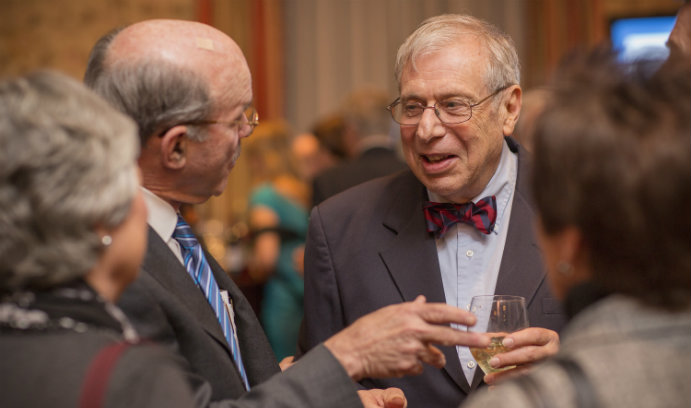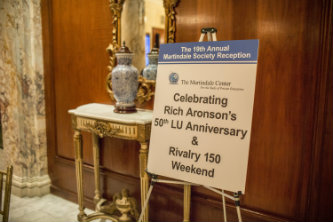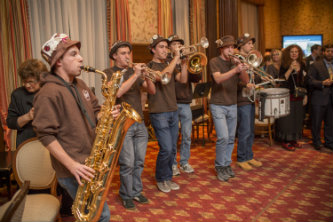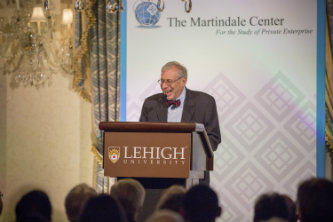Celebrating Rich Aronson

Rich Aronson's life-long dedication to Lehigh and to The Martindale Center was celebrated at the Martindale Society’s annual meeting in New York City in November. Aronson has announced he will retire after 50 years at the university.
When J. Richard Aronson first set foot on the Lehigh campus in 1965 to teach economics, the city of Bethlehem was so gritty because of a thriving steel industry that he figured he’d stay a year and move on. But Lehigh was so welcoming, he stayed for five decades.
Now Aronson, the William L. Clayton professor of Business and Economics and the director of the prestigious Martindale Center for the Study of Private Enterprise, has announced he will retire at the end of the 2014-2015 academic year.
“I feel very fortunate in having come to Lehigh,” said Aronson, who has won accolades for his teaching and for his leadership at The Martindale Center. “Lehigh offered me quite a wonderful life.”
Aronson is believed to have taught more students than any other professor at Lehigh—an estimated 20,000 students. That roster includes Interim President Kevin Clayton as well as several university trustees. He also has influenced the lives of hundreds of Martindale student associates who have benefited from stimulating, life-changing trips to countries that included Slovenia, Colombia and Greece in recent years and to Argentina, Germany and France in earlier decades.
“My theory has always been that you can’t teach anybody anything,” said Aronson. “What you can do is inspire people to learn, because they’re going to have to learn it on their own sooner or later.”
In recognition of his life-long dedication to Lehigh and to The Martindale Center, Aronson’s colleagues, former and current students and Lehigh administrators came together at the Martindale Society’s annual meeting in New York City in November to celebrate Aronson on his golden Lehigh anniversary. The celebration was part of the Alumni Weekend festivities that marked the 150th playing of the Lehigh-Lafayette football game in Yankee Stadium.
“To his students, Rich is more than just a great teacher,” said Sarat Sethi ’92, a Lehigh trustee and president of The Martindale Society, in his remarks. “He’s a dynamic leader, and he’s a shining example of mentorship at its best. He’s also something of a father figure. He’s concerned about his students’ welfare and constantly on the lookout for all of our interests.”
Sethi, who traveled to Czechoslovakia as a Martindale student associate in 1991, has firsthand knowledge of Aronson’s natural talent for building relationships. He said it was Aronson who first introduced him to Douglas and Gay Lane ’67—a meeting that led to an internship, Sethi’s first job and his current position as managing director and principal at Douglas C. Lane and Associates in New York.
“You’ve brightened the lives of tens of thousands of students … for 50 years, and you are an inspiration to all of us,” Sethi told him.
The early years
Aronson was a chemistry, then math, major at Clark University before his professors sparked his interest in economics. “I felt I was doing something important by studying the economy in a world that was coming off the Depression,” he said in a recent interview. “The Depression experience was still quite strong in the late ‘50s, 1960s…We all thought we were part of this revolution. We had something to say.”
He became so close to his economics professors that Aronson collaborated with a mentor, Jim Maxwell, on one of his books, Financing State and Local Governments, and several articles, and he sought his professors’ counsel in making his decision to come to Lehigh. In teaching economics, and later money and banking and public finance, Aronson took a cue from the professors who had inspired him.
“What they were passing on to me is that the most important responsibility you have at the university is helping students, dealing with students,” said Aronson.
In his early years at Lehigh, Aronson taught the only section of what is now called Eco 1, a required course for business and engineering students but one that many arts and sciences majors also chose to take. He taught about 1,000 students each academic year in Packard Lab Auditorium, and in that mix, he said, were Lehigh athletes, band members and fraternity members. With such diverse groups, the challenge was making the course interesting to everyone—and he often did that with humor. He would show respect too for student traditions, such as inviting the marching band into his classroom each year in a lead-up to the Lehigh-Lafayette rivalry games.
“This is a nice place, Lehigh,” said Aronson, whose wit made lectures memorable. “It’s easy to want to be interested in others’ needs.”
Joe Sterrett ’76, the Murray H. Goodman Dean of Athletics, was a student in Aronson’s upper level public finance class. He has said that Aronson brought economic theory to life by providing examples that students were able to relate to, such as using campus parties as an example of supply and demand. Knowing at the time that Sterrett played quarterback on the Lehigh football team, Aronson would also end Friday classes by making a Good Luck Prediction for that weekend’s game.
“By valuing what I valued, he made me want to do well in his class,” Sterrett has said. “I worked very hard for him because I didn’t want to disappoint his sense of my potential.”
Aronson received four teaching awards during his tenure: the Lehigh University Award in 1968 for distinguished teaching by a junior faculty member; the Stabler Award in 1974 for demonstrating mastery of his field and superior ability in communicating it to others; the Deming Lewis Faculty Award in 1984, given by the Class of 1974 to the faculty member who most significantly influenced their educational experience; and the Beta Gamma Sigma Award presented by the Business Honorary Society.
He also received the Hillman Award for service to the university and the Libsch Award for research. From 1984 to 1988, he and his wife Judy served as the first resident headmasters of the Taylor Residential College, providing cultural experiences to 160 students each academic year. A two-time Fulbright scholar, Aronson is also an honorary professor at the University of York in England.
An international research experience
Aronson distinguished himself at Lehigh as director of The Martindale Center, a position he has held since the center’s inception in 1980. Each year, he and other professors have taken students to another country or to other U.S. states to study their economy. The program is competitive, with 75 to 100 students vying for 12 spots.
Sethi, in his remarks at the Martindale Society’s annual meeting, said Aronson’s Martindale Associates program was groundbreaking: it was one of the earliest programs to offer students a global business and cultural experience, it effectively created one of Lehigh’s first interdisciplinary programs, and it was one of the first to pioneer undergraduate student research. The students’ works are published annually in a dedicated journal, Perspectives of Business and Economics.
Among Aronson’s more memorable experiences was the 2010 Martindale trip to Iceland, then in the throes of a financial crisis that involved the collapse of the country’s banks. Students met with Iceland’s movers and shakers, including chief economists of banks and members of Parliament. “It was a very emotional experience,” said Aronson, remembering students’ talks with a chief economist who was “in tears almost” as he took responsibility for the state of affairs.
In a 1994 trip to Argentina, the Martindale associates were caught in a political net that they didn’t quite understand, he said. The country was in the midst of an election, and those setting up appointments for the Lehigh students were members of one political party. “When the other party found out,” he said, “they hijacked our students, in a sense, to give the other side.” Aronson also remembers that trip as the time he had to give an extemporaneous speech, when he learned on arrival to the country that members of Parliament were expecting him to make a keynote address.
An endowment at The Martindale Center has been established in Aronson’s name.
Last year Martindale student associates traveled to Slovenia, where they heard from former Deputy Prime Minister Davorin Kračun, examined a prototype aircraft at Pipstrel, and enjoyed a traditional closing banquet at Ljubljana Castle. This summer, students traveled to Portugal to examine timely issues that include Portugal-NATO relations and the causes of Portugal’s financial crisis.
At his anniversary celebration, Aronson was presented with a bound book that contained photos of the many research trips taken by the center’s student associates to more than 20 countries, including to Mexico, Argentina, Ireland and Colombia. A table is being made for him out of the trunk of one of the larger oak trees that came down on the Lehigh campus during Hurricane Sandy. Also, Paul Salerni, professor of music, arranged “Richie’s Waltz,” and professors joined in the music performance.
As Aronson reflected on his years at Lehigh, he noted Bethlehem’s metamorphosis from a once gritty city (the steel industry is long gone) into a cultural hub that includes Lehigh’s Zoellner Arts Center. And though he will be retiring, he won’t be leaving Lehigh, he said. He plans to stay connected to the Martindale Center, particularly its former student associates, and to continue his research in public finance, in the areas of pension funds and estate and inheritance taxes.
Story by Mary Ellen Alu
Photos by Academic Images
Support the J. Richard Aronson Endowment for the Martindale Center, which honors Professor Aronson's life-long dedication to Lehigh and to The Martindale Center.
Posted on:




